Although maintaining a reef aquarium can be a daunting task for beginners, caring for colt coral is quite easy and satisfying.
So, if you are a beginner aquarist who loves to keep a reef tank, then we would recommend colt corals as your first-ever experiment.
In this article, we have explained what colt corals are, how to keep them in your aquarium, common problems, and also fragging and feeding options.
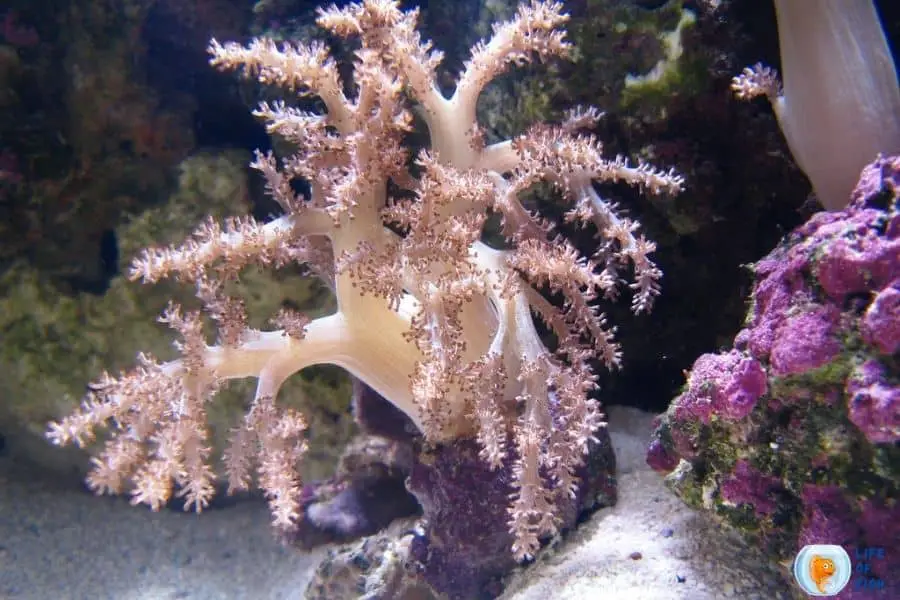
Is Colt Coral a plant or an animal?
Jump To
- 1 Is Colt Coral a plant or an animal?
- 2 Does colt coral have a lifespan?
- 3 Can we grow corals at home?
- 4 What are Colt Corals?
- 5 Is Colt Coral aggressive?
- 6 Colt Coral Behavior
- 7 How do you take care of a Colt Coral?
- 8 Common problems
- 9 Diseases
- 10 tank mates
- 11 Fragging Colt Corals
- 12 Feeding Colt corals
- 13 Conclusion
Coral is a multi-cellular marine creature with soft tissues and a hard calcium carbonate skeleton.
Many colt coral enthusiasts refer to them as “animals” because they move around the tank, change orientation in response to light, etc.
But some experts argue that they are actually invertebrate animals rather than true cold-blooded vertebrates.
Anyway, colt corals are amazing creatures that look like plants but behave like animals. Colt corals live in colonies and depend on each other for survival.
The colt coral family includes brain colt coral, lettuce colt coral, spaghetti colt coral, etc., all of which have different looks and behavior patterns.
Does colt coral have a lifespan?
Yes, they have a lifespan. But, the exact lifespan is unknown because people have adopted keeping corals lately.
Colt corals are durable and hardy creatures so, we expect they also have a long life span of hundreds of years like other hard corals.
Can we grow corals at home?
Yes. Thanks to recent advancements in Aquarium technology, anyone with some knowledge can grow corals at home.
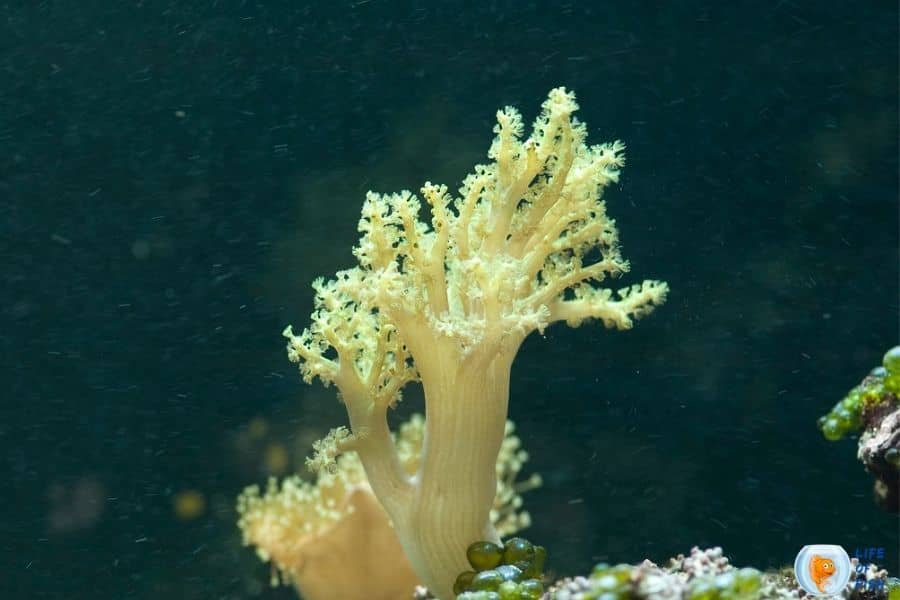
What are Colt Corals?
They are soft corals that belong to the Cladiella genus. There are over 60 species of them but they all share similar characteristics.
They are originally marine invertebrates that inhabit reefs in the Indo-Pacific region. They can be found in Australia, Micronesia, Indonesia, Japan, and the Philippines.
The name colt coral (Cladiella sp ) is derived from the Greek word “klados” and it means branch.
They are also known as cauliflower colt, soft finger leather coral, blushing coral, or seaman’s hand coral.
appearance
There are various forms that include branching structures, grape-like clusters, or solid bases with thin shoots that grow vertically upward.
They have a small size and can be placed on rocks or kept in caves to create shelter for other fish species.
They exhibit bright and attractive colors such as yellow, green, brownish-white, or purple depending on species.
Some of these soft corals sprout projections like spaghetti colt coral while others are named after their unique appearance such as Cauliflower colt coral, lettuce colt coral.
size
They can reach a height of between 0.25 inches to 16 inches, depending on species and water temperature.
distribution
These soft corals are distributed in warm water regions including the Indo-Pacific region, South Pacific Islands and the Red Sea.
They are more abundant in Hawaii, Samoa, Fiji, and Tonga. These are typically found in colonies on the tops of reefs.
Is Colt Coral aggressive?
They are aggressive and they sting other colt coral species or even polyp extension of their own colonies with their sweeper tentacles.
They even sting some fish and emit some chemicals to ward off other creatures from entering their space.
Therefore, it is essential to provide enough space between them and other species.
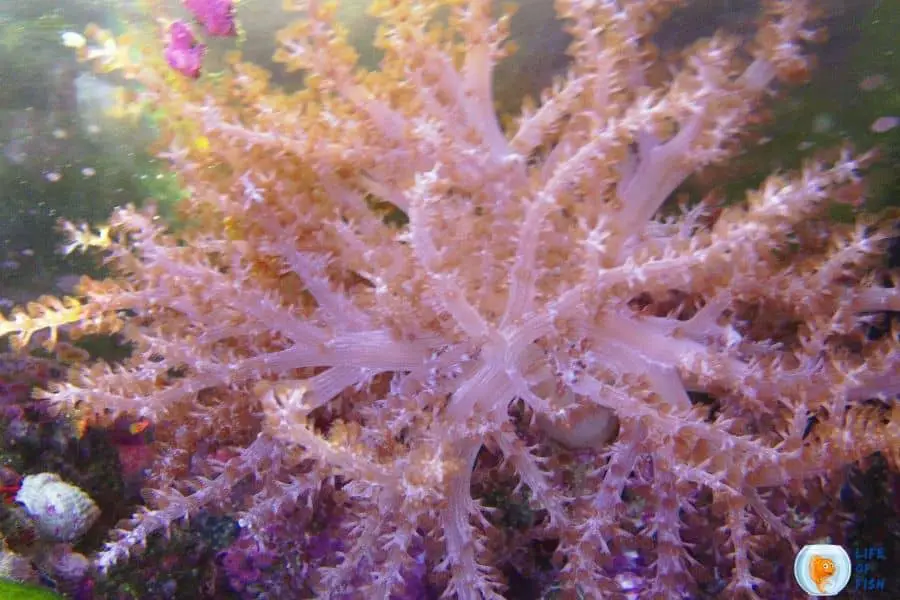
Colt Coral Behavior
They grow as colonies and live in a group. They combine together to form a single structure or colony that can grow up to 16 inches.
These colonies are very territorial and attack any other species that come near the coral.
However, they do not attack some useful fish like clownfish because both species have a symbiosis relationship.
They emit some chemicals that prevent other corals and predators from attacking these fish. On the other hand, these fish help them clean themselves.
How do you take care of a Colt Coral?
Taking care of them is easier than taking care of other coral species. You just need to provide a them with ideal water conditions in the aquarium with feedings.
A large number of colt corals are available in the pet market, but not all have similar needs.
So before buying a colt coral from your local fish store, make sure you check its requirements thoroughly because different corals respond differently to water quality and temperature changes. For instance:
- Brain colts won’t survive long in a colt coral aquarium.
- Some colt corals grow quickly and need to be moved into larger tanks within six months of purchase.
However, below are the general requirements of colt coral in an aquarium.
Lighting
These colts require a lot of light to survive in the aquarium environment as they are photosynthetic creatures.
You should provide them with at least a 60 W power compact fluorescent bulb or 150W metal halide above the colt to stimulate growth.
In addition, colt corals require an intense light source because they live in water regions where the sun is very bright and strong.
In case you cannot provide them with high-intensity lights like metal halide or LED systems, then use T-12 fluorescent lamps instead of power compact bulbs as these will not provide colts enough light.
Water temperature
The ideal water temperature is between 72-78 F, but colts can adapt to a wide range of temperatures from 60F and 90F.
However, the best temperature ranges are 73-75 F. Furthermore, colts need a stable temperature because they do not adapt to fluctuations in water temperature.
water conditions
Colt corals do not have a calcified skeleton structure. therefore, they are a little bit more tolerant of calcium in the water.
However, like any other corals, these creatures can not tolerate swings in pH, temperature or salinity.
Suitable water conditions for colts are as below.
- Water hardness- dKH 8-12
- pH level- pH 8.1-8.4
- Salinity- sg 1.023-1.025
- Nitrate- 1-2ppm
- Calcium- 400-450ppm
- Alkalinity- 8 to 9 meq\L (400-450 ppm)
Colt corals and Water Movement
You should provide colt corals with a moderate or high flow rate of water as these species live in areas where the current is fast-moving.
However, you should not make it too strong because colts do not adapt to strong currents.
placement
Colt corals are very adaptive to their placement in the aquarium.
You can place colts anywhere as long as they receive enough light, required water conditions and food supply from water currents.
However, when dealing with corals, ensure that the space between two corals has at least 3 inches to avoid aggressiveness among corals.
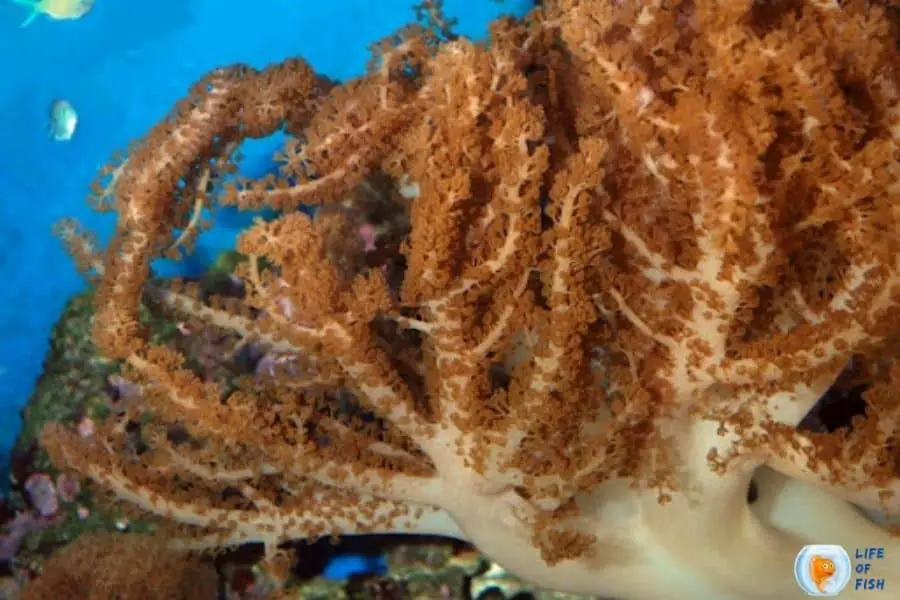
Common problems
Colt corals are very tough animals, but there are a number of problems that colts may face if you do not take care of them properly.
- Colts may lose their tentacles if they are not receiving enough light for photosynthesis. You should ensure that they receive 15 or more hours of lighting per day to avoid this problem.
- Colts can suffer from tissue loss because it is difficult for these creatures to regenerate lost tissues quickly like other polyp corals.
- Colt may die because of rapid swings in water quality, temperature and pH.
- Colts can be killed by other colt corals or fish if there is not enough space between them.
Diseases
Since colt coral is a sensitive species, it may not adapt to new conditions quickly. This makes colts susceptible to diseases like flatworms and brown jelly infections.
Often, these colt coral diseases are also found in other corals so it is important to treat colts and all the other species together.
Usually, these infections occur when you do not quarantine new fish or coral and introduce them to your main tank immediately.
You can easily avoid infections by disinfecting new species in an Iadine solution or giving them a freshwater dip before introducing them to your main tank.
If you already have infections in your reef tank, then fence off the infected coral, remove it from the tank, cut or peel of the infected area and give it an iodine bath for a few minutes.
You can also do a freshwater dip to remove any unknown infections.
tank mates
Colts are passive species that don’t attack other species when given enough territory and ideal water conditions.
You can place colt corals in the same tank with other colts, lps, or soft coral species. However, the golden rule is, do not place two corals closer than 3 inches.
Some suitable coral tank mates are,
- Kenya
- leather finger
- green star corals
- xenia
Never place colt corals with aggressive coral species to prevent possible attacks and toxin release.
If you still want to house aggressive coral species give it at least 8 to 10 inches of space in the aquarium.
Colts are very sensitive to diseases so avoid placing them near aggressive fish like lionfish and triggerfish because they may damage colts due to their sharp spines.
Colt corals are generally friendly with reef-safe fish species. For example, they will do fine with fish like green mandarin, clownfish, and cardinalfish.
However, other fish species like dwarf angels, puffer, and Foxface will have trouble pairing with colts. Therefore, check their reef compatibility before, housing fish with colts.
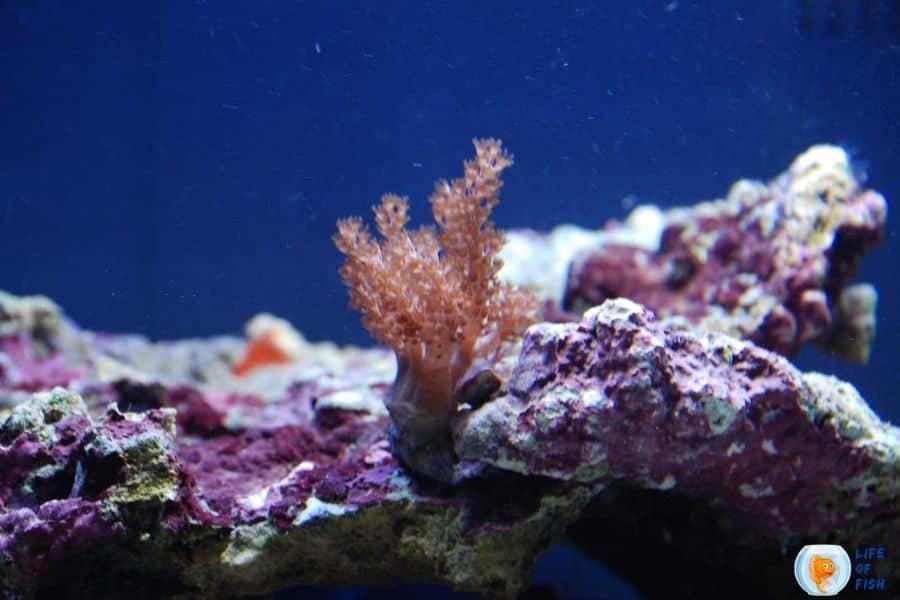
Fragging Colt Corals
Cladiella reproduces either sexually or asexually. Colts can reproduce by releasing gametes (reproductive cells) in the wild or via fission and fragmentation.
Fragmentation is a process of colt reproduction where fragments are cut from the parent colt corals with sharp blades.
These pieces grow into new colt colonies that can be kept in aquarium tanks or sold to other hobbyists for profit. However, not every colt fragment will grow into colts that reproduce.
To frag colt corals you need to use sharp and clean tools like a saw. bone cutters, Dremel, or disc.
We find Dremel to be easier when cutting colts. But, you can use any sharp tool you already have after cleaning it.
After cutting the coral, you need to disinfect it in an iodine solution to protect it from pests infections and help it heal fast.
Now dry your coral with a towel and spread some glue or two-part epoxy on the cut. After drying the glue, you can put them in the reef tank to grow it back.
Now all you have to do is observe the fragment in the reef tank for several days.
Before cutting coral, you should do everything you can to protect yourself from toxic mucus released from the coral.
To protect from chemicals such as glue and slime produced by coral, use latex gloves. Eyewear protection is also crucial.
It will take from a few days to a few weeks for the fragments to grow into new coral. If you used sharp and clean tools and disinfect them properly, they will grow back easily.
Feeding Colt corals
Colt corals get their energy from two sources; photosynthesis and filter-feeding zooplankton.
Its food is derived mostly from the light-driven process of photosynthesis, which is supported by symbiotic algae zooxanthellae living inside its body.
90% of the energy in the colt reef comes from this algae. Therefore, providing medium to high-level lighting with optimum water conditions is essential for these organisms to thrive.
These creatures are predatory in nature that feed on zooplankton including copepods, shrimp larvae, etc., along with phytoplankton cells found in the aquarium water column.
Colts that are large enough can catch small creatures like brine shrimp (Mysis) or baby brine shrimp.
But, colt corals with mouths may not be able to trap food in them if they do not have tentacles above the mouth.
To feed colt you need to put some zooplankton on its mouth and colt coral will suck it inside through filter feeding.
You can also put some zooplankton on colt coral’s tentacles to help them grow faster.
However, the feeding colt is usually not worth the effort because of the extra work you’ll have to bear.
Just like for fish tanks, you will have to clean the tank after feeding and provide a more powerful filter system to keep the aquarium clean.
Therefore, as we believe, providing enough lighting and proper water conditions is more than enough for these organisms.
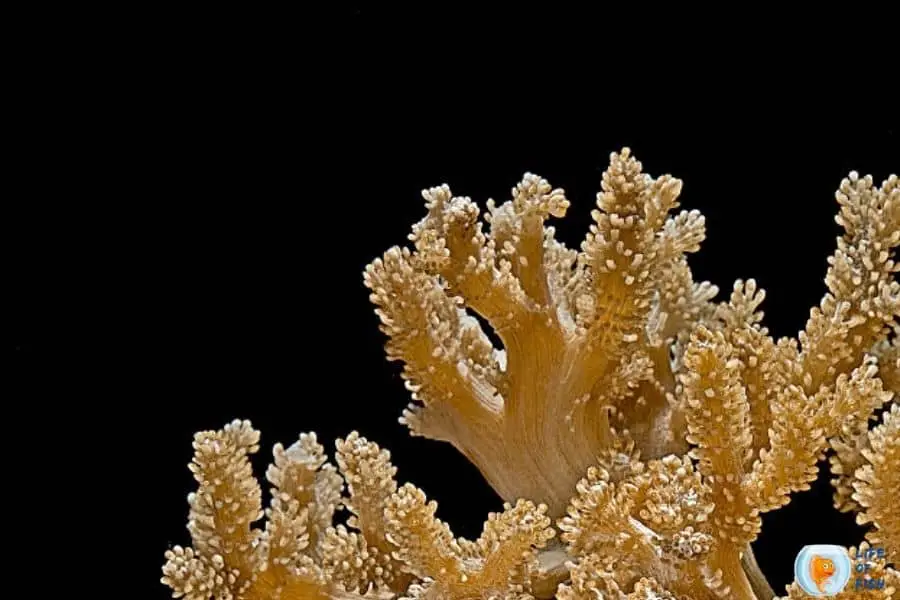
Conclusion
As you see, colt corals are one of the easiest to care for coral species suitable for beginners.
All you have to learn is to control the water parameters in the aquarium, which can be done with smart aquarium equipment like a “Programmable Auto Dosing Pump”.
Providing ideal water parameters along with strong lighting will make colts thrive.
So, if you are a beginner aquarist who is interested in keeping a reef aquarium, then colt coral is an excellent choice to learn the ropes of the reef aquarium hobby.
Also, colts are very beautiful and eye-catching, you will have a wonderful display in your tank for sure!
Read More: Kuhli Loach And Shrimp | 11 Secrets You Need To Know |
